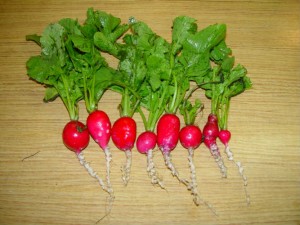What Is It? | Facts in Depth | For the Professional Diagnostician
Brassica Diseases | Clubroot
Clubroot
Identification
The pathogen is soilborne, and symptoms first appear above ground as wilting and chlorotic leaves. Stunting occurs in new growth and the plant eventually dies. When the roots are examined, they are swollen, distorted, and malformed. More specifically, there is abnormal enlargement of the root system forming galls. The root malformation impairs the host plant to uptake water.



(Left: Turnip; Middle: Radish; Right: Mustard Greens)
Pathogen Biology
Soilborne fungus; survives in the soil for many years (7 to 10), even in the absence of host crops, as dormant resting spores. The fungus can spread through the soil through machinery, contaminated water supplies, infected transplants, and by field animals. When soil conditions are favorable (high soil moisture and soil temperatures between 64F and 77F), the resting spores germinate. Zoospores are produced and infect new healthy plants; new races are formed and developing. When roots die and decay, the resting spores are released into soil, where they survive for many years.
Favorable Environmental Conditions
When soil conditions are favorable with high soil moisture and cool soil temperatures between 64oF and 77oF, the resting spores germinate. Also, acidic soils provide the most favorable environmental conditions for the pathogen.
Often Confused With
- Root knot nematode – The roots are highly symptomatic when infected with clubroot and can sometimes be confused with the galls caused by root knot nematodes. The galls caused by root knot nematodes are usually more spherical and are generally not as large as the clubroot galls.


Scouting Notes
Any signs of wilting in cool temperatures and wet soil conditions may be an indication of clubroot disease. Dig up suspect plants and inspect roots for galls and other malformations. Pulling plants may result in many of the galls remaining in the soil.
Thresholds
Currently, there is no threshold information for clubroot of crucifers.
Management Notes
- Use certified disease-free plants – Planting clean transplants will avoid introduction of clubroot into the growing system. It is preferable to use transplants that were originally grown in soil-less systems or systems in which soils were fumigated.
- Use of lime and fungicides – Limestone is a great and efficient way to raise the pH of an acidic soil to around 7.2 – 7.5. Although a good method for managing clubroot, limestone alone will not prevent the disease. The Midwest Vegetable Production Guide for Commercial Growers provides recommendations for fungicides that may be used to help manage this disease.
- Use sound sanitation practices – A rotation of at least 5 years out of susceptible crucifers may be effective; this includes removing any susceptible weeds, such as those in the mustard family. Always thoroughly clean and sanitize any farming equipment that is used.
